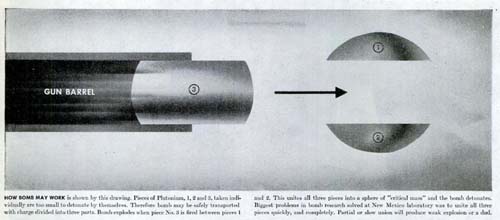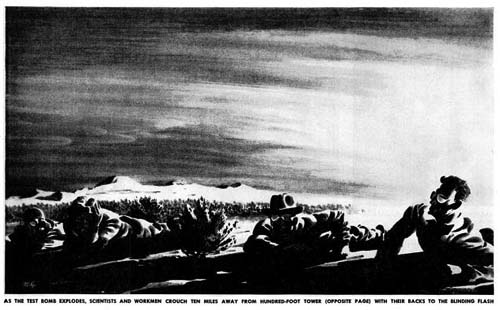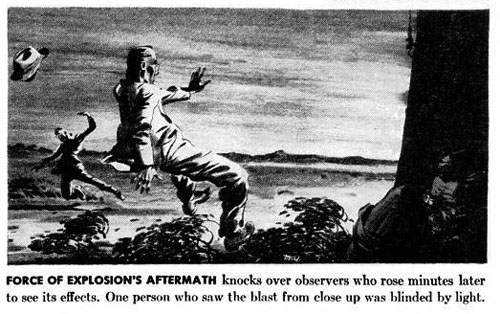Only two weeks after the bombing of Hiroshima, Life magazine devoted a huge portion of an issue to the Manhattan Project, in particular the “Trinity” test. It was mostly a popular distillation of the various press releases that the War Department had released (penned primarily by William Laurence of the New York Times) and the Smyth Report.
What they lacked, though, were good pictures. The only photos of the “Trinity” test that had been released at that point were of the familiar fireball at a few milliseconds (what I always think of as a nuclear “blob”), and most of the other photos that existed were generic headshots of personnel. Not exactly up to Life‘s visual standards. So Life instead hired someone to illustrate all of those things about the Manhattan Project that were previously only described in text. The results are pretty interesting — both as illustrations of the unseen, and because they attracted official attention for being a little too accurate. 1
First drawing of interest: we have an early drawing of the bomb itself. (This is one of my obsessions, as you may have figured out. I’ve been working on how people draw the bomb for a long time now, and have collected quite a set of these drawings.) It’s a curious rendering of a gun-type plutonium weapon, implausible not just because they didn’t know that plutonium couldn’t be used in a gun-device (implosion was still secret), but because the “projectile” piece, even if it actually made it to the “target” (that gun barrel is pretty short), would probably fly through the other side of it. But hey — it’s not an engineering diagram, just an attempt to get a concept across. (Oddly, you might think that the “target” is meant to be a ring, but the caption makes it clear that it is not — it’s really meant to be the top and bottom of a sphere, disconnected. Really pretty odd.) And for the record, they make it pretty clear in the caption that this is just how it “may” work: they aren’t staking too strong a claim to this drawing.
Richard Tolman, General Groves’ technical advisor, reviewed this article shortly after it was published. He wasn’t too concerned with the drawing. “There is a picture of the gun method of assembly,” he wrote to Groves. “This is not very much like the actual gun assembly used, and is probably only a good guess.” More troublesome for Tolman was a note on the same page that said two neutrons per fission were emitted. This, he noted, “is closer to the correct number than we allowed in the Smyth Report.” 2
Second drawing of interest: the “Trinity” tower. Now unfortunately, Google’s scan of this is rather dark, so it’s hard to get a real sense of. Of note is that it is a sphere — and is not too far off in terms of what the actual “Trinity” test tower looked like, though it lacks any kind of roof. This attracted Tolman’s attention more critically:
There is a picture of the Trinity tower and of the sphere surrounding active [fissile] material which is perhaps too near the real thing to be merely a good guess. … The Trinity tower is described as a ‘hundred foot structure,’ and the bomb as a big black ball. The above items are not of a such a character as to be of appreciable assistance to an enemy except for the possibility that the ‘big black ball’ and its picture would suggest implosion.
That’s the kicker. If you knew that “Trinity” was a sphere, you might ask, why make a gun into a sphere? Unless it wasn’t a gun. Which, as we now know, it wasn’t. (This is why photos of the “Fat Man” and “Little Boy” casings were kept secret for so long.)
So did “Life” just guess well, or did somebody talk? I suspect, along with Tolman, that somebody talked. There were a lot of “somebodies” involved in the “Trinity” test, and, ironically, those who knew the least about the actual mechanism of the bomb (e.g. the many soldiers who must have seen them hoisting the “Gadget” to the top) probably would have been the most likely to describe it as a sphere — they wouldn’t have known that even the rough shape of the bomb was revealing of its intimate internal nature. But this is just speculation on my part. (Laurence, for his part, would have known that the sphere was considered quite sensitive.)
Of course, it didn’t really matter, since the Soviets already knew about implosion, thanks to their spies, but that wouldn’t come out for some years.
There are a few other wonderfully dramatic drawings as well. I really like the one above, of the scientists laying down with their backs to the blast. The use of light and shadow by the illustrator (a certain Matt Greene, who seems to have done a lot of illustration for Life over the years) is pulled off quite well.
I love the above — both for the pulpy quality of the guy holding up his hand as his hat flies off, as well as the guy in the back there who is being dramatically flung off of his feet. I think the illustrator got a little carried away in this one.
Speaking of illustrating the Manhattan Project, on Friday, May 11, 2012, the Center for History of Physics at the American Institute of Physics (my ever-patient employers) are going to be hosting an evening event to celebrate Richard Feynman’s birthday. The keynote speakers are going to be Jim Ottaviani and Leland Myrick, the writer and illustrator behind the recently-released graphic novel FEYNMAN. The plans are firming up, but if you’re in the DC area (we are a short walk from the College Park station) and are interested, shoot me an e-mail and I’ll make sure you’re in the loop.
- All of these images are taken from numerous articles scattered throughout Life 19, no. 8 (20 August 1945).[↩]
- Richard Tolman to Leslie R. Groves, “Security Analysis of Articles in ‘Time’ and ‘Life’ for August 20,” (n.d., ca. 20 August 1945), in Manhattan Engineer District (MED) records, Records of the Army Corps of Engineers, RG 77, National Archives and Records Administration, Box 32, “Censorship.” Note that despite the name of the folder, there was no censorship exercised here.[↩]





